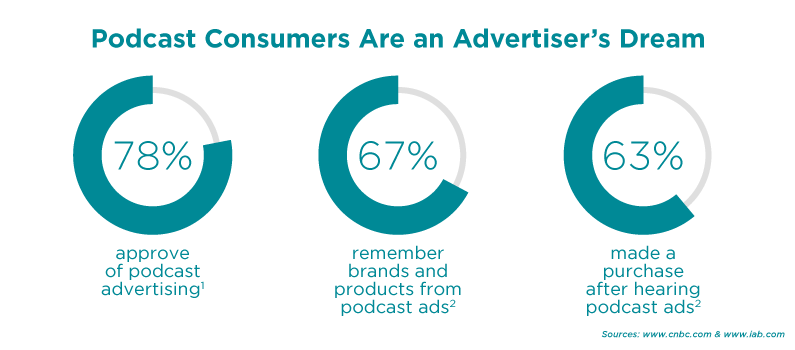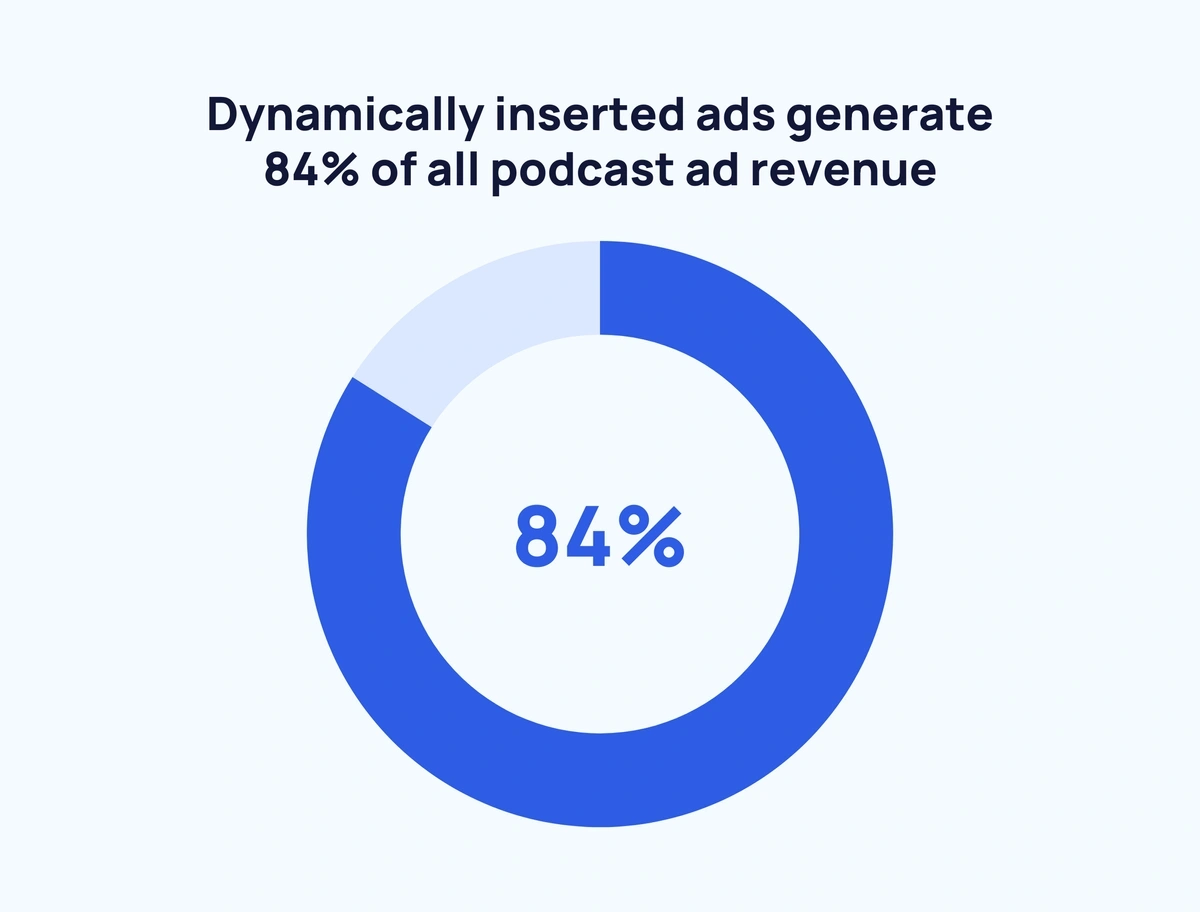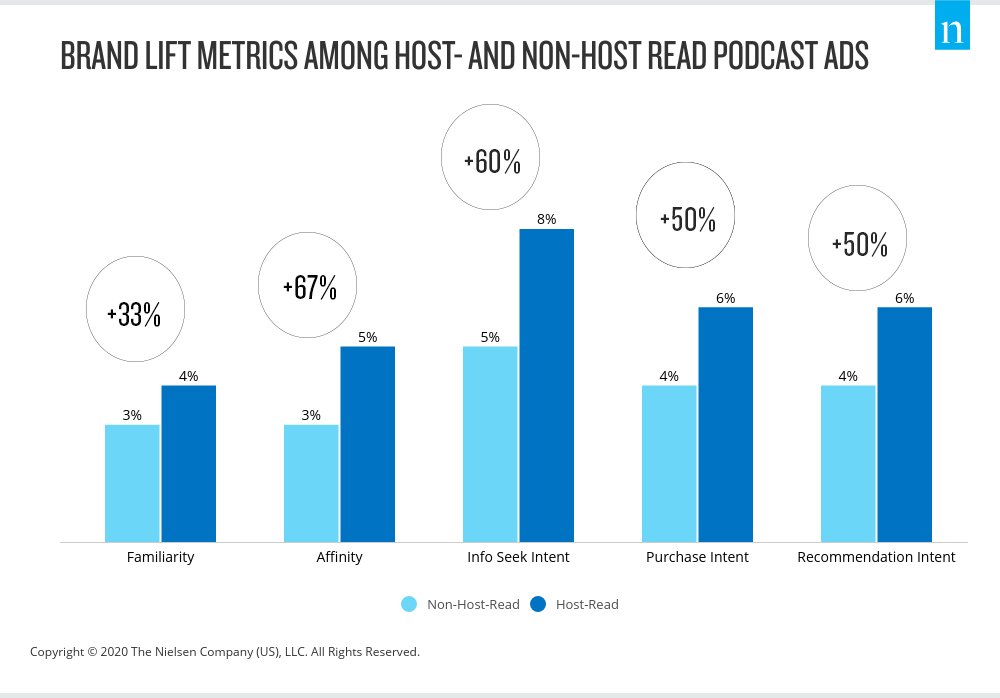CPM is a traditional online marketing metric in which companies pay for views/listens/downloads of their advertisement. CPM stands for ‘cost per mille, i.e. ‘cost per thousand’, so a CPM campaign is an advertising campaign in which an advert is played to X 1000s of impressions.
The advert can be ‘baked-in’ into the recording itself, which means it cannot be removed or changed, or can be placed at a particular timestamp using a dynamic ad insertion system, which allows the ad to be changed as needed.
These timestamps are commonly assigned to one of three categories; pre-roll, mid-roll and post-roll.
This refers to the positioning on the advert within an episode. In general, pre-roll means before the main content starts, mid-roll means during the main content and post-roll means after the content has concluded.
There are pros and cons to these three positions:
| Position | Pro | Con |
| Pre-Roll | Highest listen rate / Highest conversion rate | Most expensive |
| Mid-Roll | High listen rate / High conversion rate / More affordable | Does not maximise ad exposure. |
| Post-Roll | Most affordable | Lowest listen rate / Lowest conversion rate |
Ad positioning will often be determined by budget but the most effective, and thus the most common, is a pre-roll host-read ad campaign.
A host-read ad, as the name suggests, is an ad read by the hosts of the podcast. The advertiser generally provides a number of talking points and the hosts will discuss the product or service in their own style while also including this essential information.
A pre-recorded or standard ad, again as the name suggests, is an advert prepared by the advertiser prior to the campaign start date and provided to the hosts in mp3 or wav format.
While the latter allows the advertiser more control over content, host-read ads are more common:
The reason for this is down to the audience’s affinity with the show hosts and a desire to hear recommendations from them directly, rather than from an entity they are not directly engaged with:
The costs displayed on our rates card represent the pros and cons detailed above. As combining the host-read format with the pre-roll position yields the highest conversion rate, this cost is the highest. Similarly, post-roll position yield the lowest conversion due to the listening drop off rate, i.e. fewer people are still listening attentively at the end of the episode, thus the lowest cost:
Combined positions within a single episode can also increase conversion rates, although in this instance we would always recommend separate ads to maintain listener interest:
In order to calculate a campaign cost, decide on a budget or how many listeners you want to reach.
If you have a budget in mind:
Budget / CPM Cost = x 1000 listens
For example:
£3000 / £30 = 100 x 1000 listens = 100,000
If you have a total number of listeners you want to reach:
Total Listens / 1000 = Factor x CPM Cost = Total Campaign Cost
For example:
30,000 / 1000 = 30 x £30 = £900
There is no average campaign cost as campaigns are tailored to meet the client’s needs.
If a client says ‘we need to make some serious noise about an upcoming release, we want to reach 30,000 of your listeners”, then we would likely suggest a host-read pre-roll campaign that would cost £900:
30000 (total listens) / 1000 (CPM factor) = 30 (groups of 1000 listens)
30 (groups of 1000 listens) x £30 (cost of host-read pre-roll) = £900
Alternatively, a client may say “we have a budget of £300, what can you provide for that?”, in which case we might suggest a pre-recorded mid-roll, providing 17,500 listens:
£300 (campaign budget) / £17.50 (cost of pre-recorded mid-roll) = 17.5 (groups of 1000 listens) = 17,500
So it’s entirely up to you whether budget or reach are the primary driving factors for your campaign.
This depends on 2 factors; which show your ad runs on and how many episodes your ad is assigned to. The key in deciding this is understanding the difference between total episode listens in the first 30 days and total series listens in any 30 day period.
The former is the total number of times a single episode is listened to in the first 30 days from the release date.
The latter is the total number of times all episodes in a show are listened to in any given 30 day period.
If your campaign allowed for 10,000 listens and a recently released single episode was getting 10,000 listens in the first 30 days, if your ad is only applied to that single episode, the campaign would last approximately 1 month. If the ad is applied to the 2 most recent episodes, the campaign total would be reached faster, perhaps in 2-3 weeks (please note it is difficult to give exact figures for past episodes as the data is only provided for the first 30 days of release).
The dynamic ad insertion system we use is automated, so we set up the campaign with a total listens limit and once the campaign is live, your ad will appear in the requested roll position on the agreed number of episodes until that limit is hit, then the ad will stop running. We can also set an end date for the campaign, after which the advert will stop running.
As of March 2024, the two main LDTL shows are grossing over 110,000 listens per month combined. Your campaign will reach listeners up to the limits of the campaign parameters you have set, or up to this total if your budget allows.
It is important when thinking about campaign effectiveness to make a clear delineation between what an advertiser and a podcast producer consider a conversion to be.
While an advertiser will likely consider a conversion a sale or service sign up, a podcast producer usually defines a conversion as a click-through. Content producers provide a shop window in which to promote an advertiser’s wares. As they have no control over the user experience once a listener arrives at an advertisers website, what that listener does from that point is really down to the advertiser and the level of conversion rate optimisation in place at their end.
As you can see from the above info, a conversion is defined as the ‘number of attributed website visitors a campaign received as a percentage of listeners reached’. To that degree, our focus is on providing as high a click-through rate as possible. To track this, we route you chosen campaign link through a redirect plugin on our website, which tracks the number of uses. This information is then provided, along with the total listens data, at the end of the campaign:


Additionally, we recommend advertisers provide either discount codes or custom URLs to help track traffic and/or conversions at their end. These can then be referenced during the ad and included in the episode descriptions.
Of course! You can’t smell perfume or feel the texture of clothes through your computer screen, but both of these products do very well through online sales. In the same regard, our ability to promote visual products is not hampered by the fact our main shop window is an audio format for the same reason host-read ads are more popular than pre-recorded ads: it comes down to the audience’s affinity with the show hosts and a desire to not only hear recommendations from them directly but also to support the show through engaging with their chosen advertisers.
If an advertiser feels that the visual side of a particular product is essential to its promotion, we also provide a product review package that offers additional video content that can then be referenced during the podcast ad and traffic directed to there before being funnelled to the advertiser’s chosen link.







